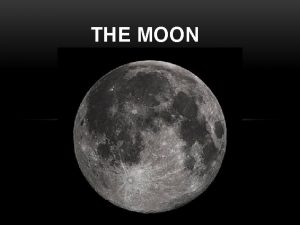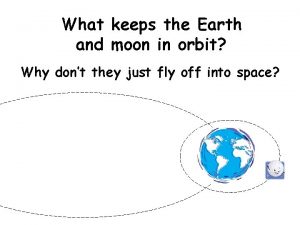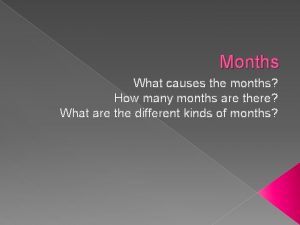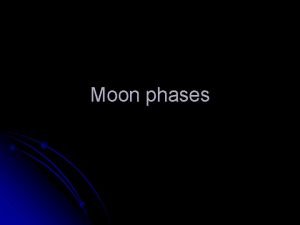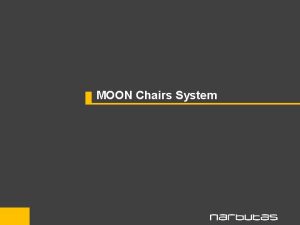Moon Months Miss Fogg Fall 2015 DQ Make









- Slides: 9

Moon Months Miss Fogg Fall 2015

DQ: Make 3 observations

Moon Months • How long does it take the moon to orbit Earth? • …it depends! Watch the following animation Months Animation • What is the difference between a sidereal month and a synodic month?

Sidereal vs. Synodic Months Sidereal month: 27. 3 days - time it takes for moon to complete 360 degree revolution around Earth (Earth, moon, and distant star aligned) Synodic month: 29. 5 days - time it takes moon to complete full cycle of phases (new moon new moon)

Sidereal vs. Synodic Months

Modeling Earth-Moon-Sun • You and your partner will model how the moon and Earth interact during Sidereal and Synodic months. • Let’s go outside!

Ch 22 Exploration Lab • Complete the Ch 22 Exploration Lab: Modeling Synodic and Sidereal Months • Due tomorrow Oct. 20 th

Sidereal Month • The two different ways to measure a month are called sidereal and synodic. • The sidereal month is the time it takes for the Moon to complete one full orbit of the Earth, measured with respect to the distant stars. • The major assumption in determining a sidereal month is that the distant stars are fixed relative to Earth, and for the most part they are stationary. • The sidereal month is the Moon's true orbital period and is equal to 27. 3 days. That is, it takes the Moon 27. 3 days to be in the same position relative to the distant stars.

Synodic Month • The synodic month is the time it takes for the Moon to complete one cycle of phases. For example, the time between successive new moons. • Therefore the synodic month is measured with respect to the Sun and is approximately 29. 5 days. • Why is there a difference between the sidereal and synodic periods? • Well, the Earth keeps orbiting the Sun while the Moon is going through its phases. Thus, to go from one new moon to the next the Moon must rotate more than 360 o along its orbit. The synodic month is therefore approximately two days longer than the sidereal month.
 There are 4 seasons
There are 4 seasons What months are in spring
What months are in spring Describing winter season
Describing winter season Jessica hall miss senorita 2015
Jessica hall miss senorita 2015 Home.hiwaay.net/ krcool/astro/moon/moon tides/
Home.hiwaay.net/ krcool/astro/moon/moon tides/ Which moon phase occurs directly before a new moon
Which moon phase occurs directly before a new moon Home.hiwaay.net/ krcool/astro/moon/moon tides/
Home.hiwaay.net/ krcool/astro/moon/moon tides/ Which moon phase occurs directly before a new moon
Which moon phase occurs directly before a new moon Moon sister moon calendar
Moon sister moon calendar Why doesn't the moon fall on earth
Why doesn't the moon fall on earth






